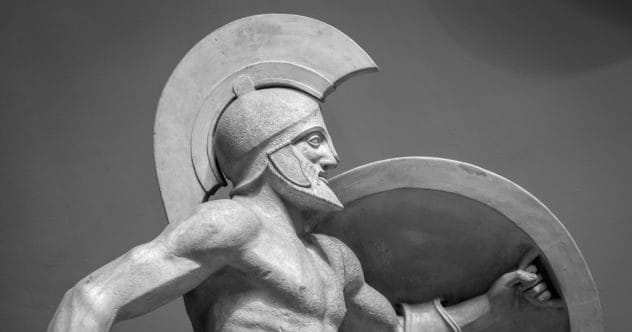Since the dawn of humanity, conflict has been a constant. Protecting the head was paramount, leading to the evolution of helmets. Over time, helmets took on various forms, some with striking decoration or crafted from unusual materials. Join us as we explore ten of the weirdest helmet designs from the ancient world.
Conical Helmets
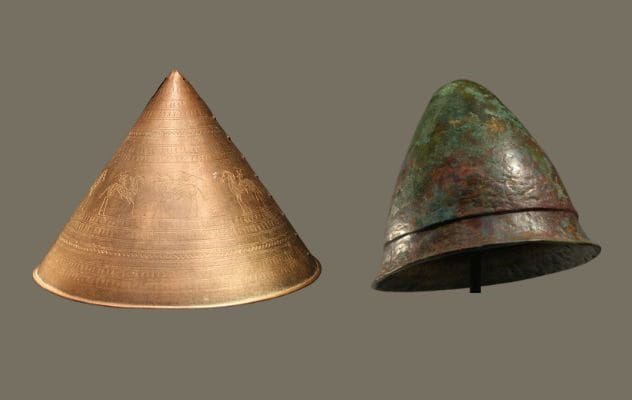
Helmets are typically designed to match the shape of the skull for optimal protection. However, ancient designs experimented with unconventional shapes. The Kegelhelm and Pilos-type helmets are prime examples of this.
The Kegelhelm, dating back to the 8th century BC, was a simple conical bronze structure, offering minimal facial protection. Its design flaws, such as crumpling upon impact, led to its decline. The pileus, a common laborer’s hat in ancient Greece, inspired the Pilos helmet in the 5th century. Crafted from bronze, this helmet maintained the pileus shape, possibly for comfort when worn with the hat underneath. Elaborate decorations and even horns have been found on some Pilos helmets.
Phrygian Helmet
Instantly recognizable from the ancient world, the Phrygian cap, with its curved, forward-bent peak, became a symbol of liberty, often donned by freed Roman slaves. Its image was famously used during the French and American Revolutions.
Following the trend of hats inspiring helmets, the Phrygian helmet emerged throughout the Greek world. Macedonian cavalry under King Philip and Alexander the Great famously wore this style. Ancient depictions of their armies commonly feature soldiers in Phrygian helmets.
Crosby Garrett Helmet
The Phrygian style’s longevity is showcased by a remarkable Roman find in Britain. In 2010, a metal detectorist discovered an ornate helmet adorned with a winged griffin statuette and a hauntingly realistic face near Crosby Garrett.
While Roman cavalry helmets with full-face coverings are not unprecedented, the Crosby Garrett example stands out for its completeness. Believed to be ceremonial, its faceplate significantly restricted the wearer’s vision, making it unsuitable for battle. Despite its historical significance, English treasure laws failed to protect it due to its copper alloy composition, leading to its auction to a private buyer for £2,330,468.
Golden Helmet of Coțofenești
Helmets provide protection, but they’ve also been powerful symbols of royalty and wealth. The Golden Helmet of Coțofenești embodies this dual role.
Discovered in the 1920s by a Romanian child, this 4th-century BC gold helmet belonged to a Geto-Dacian tribe. While offering little practical protection, its sheer gold weight (over 2 pounds) made it an impressive display of power. Adorned with apotropaic eyes and images of ritual sacrifice, the helmet holds deep cultural and symbolic significance.
War Helmet of Meskalamdug
In 1924, archaeologist Leonard Woolley unearthed the royal burial grounds of Ur, Mesopotamia. Among the grave goods in a 26th-century BC tomb was the gold war helmet of King Meskalamdug of Kush.
Shaped to mimic the king’s hairstyle, the helmet featured intricate etchings of hair strands, waves, and even the ears, with a golden band woven around the skull. This demonstrated not only wealth but also artistic sophistication.
Helmet of Constantine
Helmets can symbolize political and religious beliefs. Emperor Constantine used his to proclaim his Christian faith in the 4th century AD.
Constantine’s helmet bore the Chi Rho symbol, a mark of early Christians. His mother, Helena, brought relics from the Holy Land, including nails believed to be from Jesus’ crucifixion. One of these nails was incorporated into the helmet, as Theoderet noted, “that the head of her son might be preserved from the darts of his enemies.”
Agris Helmet
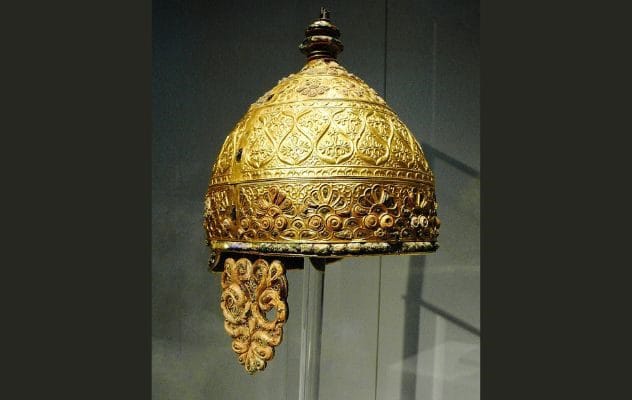
The Agris helmet, originating from Celtic France around 350 BC, showcases Celtic artistry. Discovered in a cave in 1981, the fragmented helmet was pieced back together.
Made with an iron cap plated with bronze, it features intricate interwoven leaves, vines, and branches. A horned serpent adorns the cheek guard. With gold leaf and coral detailing, the Agris helmet was likely a ceremonial piece rather than practical battle gear.
Waterloo Helmet
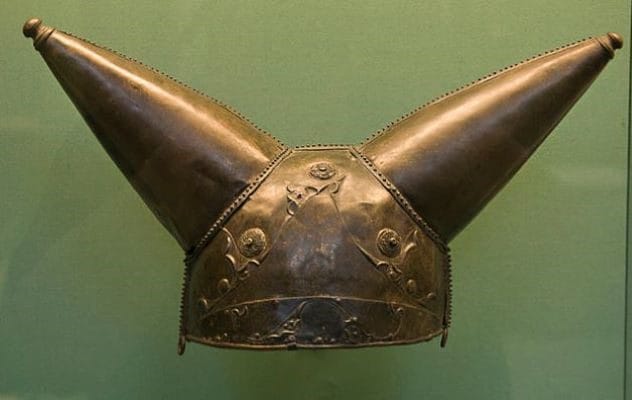
Despite popular imagery, Viking helmets weren’t typically horned. However, horned helmets did exist.
In 1868, dredging near London’s Waterloo Bridge unearthed a helmet with two large conical horns from around 100 BC. Adorned with Celtic symbols and red glass studs, the Waterloo helmet is a unique find. Although Iron Age images depict horned helmets, this artifact remains the only one discovered in Europe.
Veksø Helmets
The Waterloo Helmet isn’t alone in its horned design. Two Bronze Age helmets, the Veksø helmets, were found in a Danish peat bog in 1942.
Nearly identical, these bronze helmets feature high, S-shaped horns and raised bosses. With curved elements resembling eyes and a hooked beak, they might have symbolized birds of prey. Impractical for battle, these helmets were likely used in rituals. Their discovery in a bog suggests they were offerings to the gods.
Boar’s Tusk Helmets
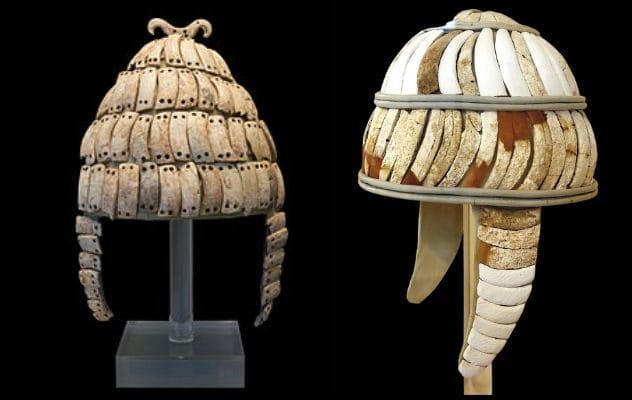
Homer’s epic poems, written around the 8th century BC, described a world from centuries prior. Doubts surrounded the accuracy of these ancient tales.
The Iliad describes a helmet intricately made: “The outside was cleverly adorned all around with rows of white tusks from a shiny-toothed boar.” Archaeology has confirmed the existence of such helmets in ancient Greece. Boar’s tusk helmets, dating from the 17th to 10th century BC, have been unearthed, validating Homer’s detailed descriptions. Their function, whether protective or symbolic, remains unknown.
From conical bronze caps to golden displays of power and boar tusk constructions, ancient helmets reveal much about past cultures, beliefs, and warfare. These ten unique examples showcase humanity’s enduring ingenuity and artistry in the field of head protection.
Which helmet design fascinated you the most? Leave your comment below!


